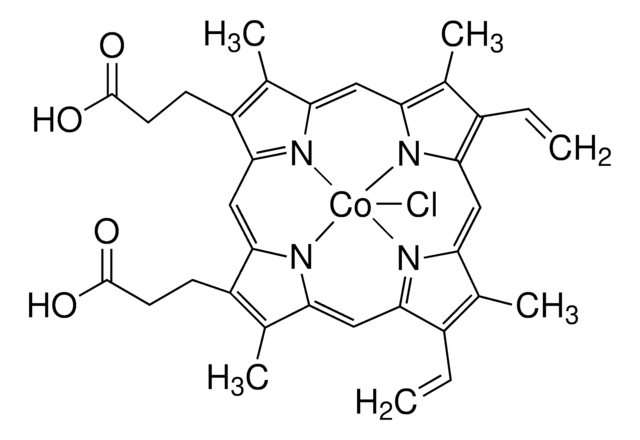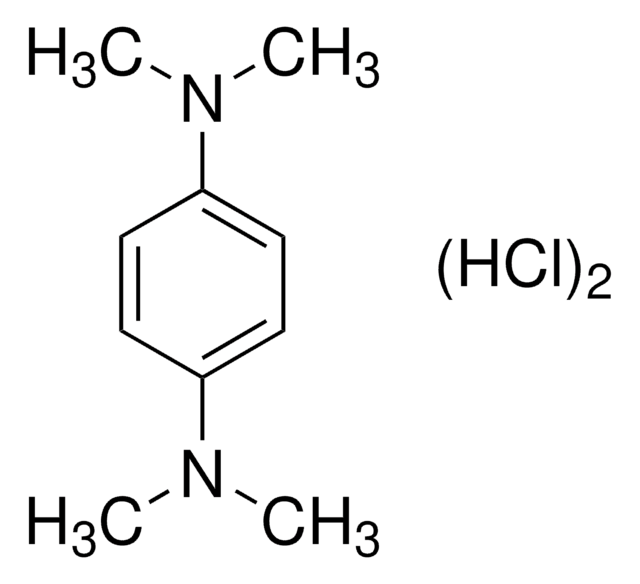C5499
Cytochrome c Oxidase from bovine heart
5 mg protein/mL
Sinonimo/i:
EC 1.9.3.1, Ferrocytochrome-c:oxygen oxidoreductase, Complex IV
Autenticatiper visualizzare i prezzi riservati alla tua organizzazione & contrattuali
About This Item
Prodotti consigliati
Origine biologica
bovine heart
Livello qualitativo
Stato
buffered aqueous solution
Attività specifica
≥20 units/mg protein
PM
300-350 kDa by gel filtration
Caratteristiche più verdi
Waste Prevention
Design for Energy Efficiency
Learn more about the Principles of Green Chemistry.
sustainability
Greener Alternative Product
Concentrazione
5 mg protein/mL
Categoria alternativa più verde
, Enabling
Condizioni di spedizione
dry ice
Temperatura di conservazione
−20°C
Descrizione generale
Research area: Cell cycle
Cytochrome c oxidase contains 13 subunits, encoded by mitochondrial genes and nuclear genome. It is comprised of two heme groups (Fea and Fea3) and two copper centers, CuA and CuB.
We are committed to bringing you Greener Alternative Products, which adhere to one or more of The 12 Principles of Greener Chemistry. This product has been enhanced for energy efficiency and waste prevention when used in biofuel cell research. For more information see the article in biofiles.
Cytochrome c oxidase contains 13 subunits, encoded by mitochondrial genes and nuclear genome. It is comprised of two heme groups (Fea and Fea3) and two copper centers, CuA and CuB.
We are committed to bringing you Greener Alternative Products, which adhere to one or more of The 12 Principles of Greener Chemistry. This product has been enhanced for energy efficiency and waste prevention when used in biofuel cell research. For more information see the article in biofiles.
Applicazioni
Cytochrome c Oxidase (CcO) from bovine heart has been used:
- to study the effect of oxidized glutathione (GSSG) on the number of total free cysteines
- in a histochemical assay to measure CcO activity in tissue sections
- to study the redox reactions of cytochrome c in isolated mitochondria exposed to blue or red lasers using resonance Raman spectroscopy
Azioni biochim/fisiol
Cytochrome c oxidase is the principal terminal oxidase of high oxygen affinity in the aerobic metabolism of all animals, plants, yeasts and some bacteria. It is present in the mitochondria of the more highly developed cells and in the cytoplasmic membrane of bacteria. Cytochrome c oxidase catalyses the electron transfer from cytochrome c to O2. This electron-transfer process produces a proton gradient across the membrane, which in turn drives the production of ATP. This enzyme is unique in providing energy for the cell bycoupling the electron transport through the cytochrome chain with the process of oxidative phosphorylation.
Definizione di unità
One unit of cytochrome c oxidase will oxidize 1.0 μmole of ferrocytochrome c per min. at 25 °C at pH 6.0.
Stato fisico
Supplied as a solution in 25 mM Tris-HCl buffer, pH 7.8, 5 mM EDTA, and 39 mM n-dodecyl β·-D-maltoside.
Codice della classe di stoccaggio
12 - Non Combustible Liquids
Classe di pericolosità dell'acqua (WGK)
WGK 3
Punto d’infiammabilità (°F)
Not applicable
Punto d’infiammabilità (°C)
Not applicable
Scegli una delle versioni più recenti:
Possiedi già questo prodotto?
I documenti relativi ai prodotti acquistati recentemente sono disponibili nell’Archivio dei documenti.
I clienti hanno visto anche
Claudia R Oliva et al.
Oncotarget, 8(23), 37568-37583 (2017-04-30)
Patients with glioblastoma have one of the lowest overall survival rates among patients with cancer. Standard of care for patients with glioblastoma includes temozolomide and radiation therapy, yet 30% of patients do not respond to these treatments and nearly all
Zong-Heng Wang et al.
eLife, 8 (2019-10-16)
Oogenesis features an enormous increase in mitochondrial mass and mtDNA copy number, which are required to furnish mature eggs with an adequate supply of mitochondria and to curb the transmission of deleterious mtDNA variants. Quiescent in dividing germ cells, mtDNA
Claudia R Oliva et al.
The Journal of biological chemistry, 291(46), 24188-24199 (2016-09-30)
The enzyme cytochrome c oxidase (CcO) or complex IV (EC 1.9.3.1) is a large transmembrane protein complex that serves as the last enzyme in the respiratory electron transport chain of eukaryotic mitochondria. CcO promotes the switch from glycolytic to oxidative
Navjot Kaur et al.
Neuron, 107(6), 1197-1211 (2020-07-25)
Neural stem cells directly or indirectly generate all neurons and macroglial cells and guide migrating neurons by using a palisade-like scaffold made of their radial fibers. Here, we describe an unexpected role for the radial fiber scaffold in directing corticospinal
Matthew W Rice et al.
PloS one, 9(6), e100054-e100054 (2014-06-19)
Perturbations in metabolism are a well-documented but complex facet of schizophrenia pathology. Optimal cellular performance requires the proper functioning of the electron transport chain, which is constituted by four enzymes located within the inner membrane of mitochondria. These enzymes create
Il team dei nostri ricercatori vanta grande esperienza in tutte le aree della ricerca quali Life Science, scienza dei materiali, sintesi chimica, cromatografia, discipline analitiche, ecc..
Contatta l'Assistenza Tecnica.






